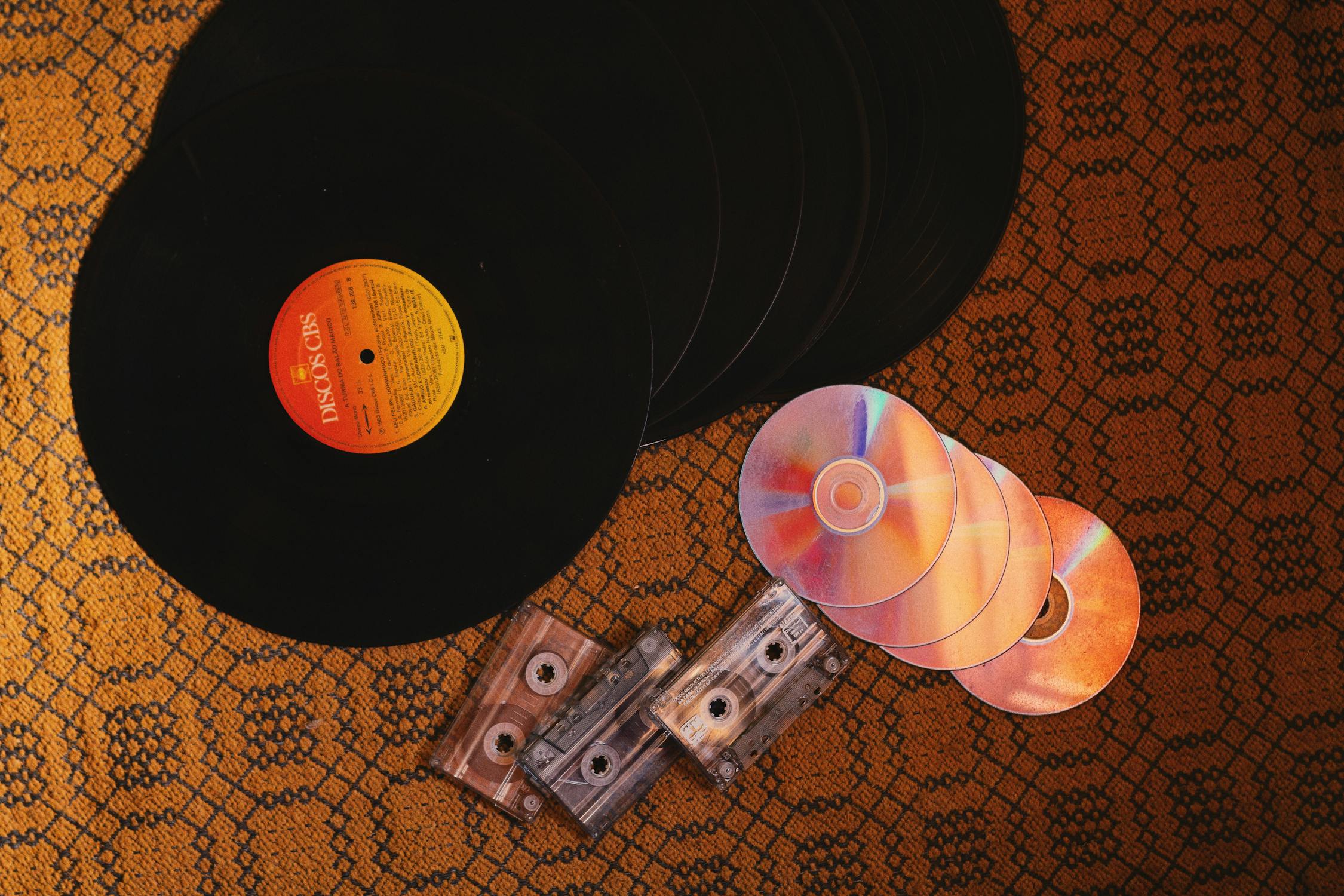5G implementation is still in its infancy. Wireless providers are researching how to create new practices that enhance the way we collaborate, share, and consume, and America’s $15 billion music industry is certainly a part of the 5G equation.
Technology has always impacted music
Historically, technological advancements have pushed the music industry forward. With each new innovation, musicians and industry leaders reach new heights in their artistic expression, the way they share and engage with fans, and how artists work together from anywhere in the world.

7 inventions that changed the music industry
- Phonograph (1877)
The original French phonautograph was a little rough around the edges, but it inspired the likes of Thomas Edison and other competing inventors to push the boundaries of emitting audio. - Headphones (1910)
The original personal listening device was created by Nathaniel Baldwin. Without private backing to take these to market, Baldwin struck a deal with the Navy to sell hundreds of headsets. Even today, the original headphone design is ubiquitous and associated directly with the creation and enjoyment of music. - The LP (1931)
The earliest vinyl records were pioneered by RCA. They didn’t take off until over a decade later, when Columbia Records rebranded vinyl LPs. Vinyl record sales have steadily grown year-over-year over the past decade, with a 61% revenue increase in 2021. Talk about timeless tech! - Phillips Compact Cassette Tape (1963)
Taking music on the go became a possibility with the introduction of compact cassette tapes. Prior to the industry’s digital revolution, cassettes were the best way to get lots of songs in a small size. Plus, the concept of personal music curation became synonymous with this era’s mixtape craze. You could record your favorite songs for a lover or friend and package them nicely with a handmade label. - The Walkman (1979)
The Sony Walkman dominated the 80’s music industry. Not only was this portable cassette player practical, but it was culturally hip. - Commercial Compact Disc (1982)
With more reliability, higher quality audio, and easier portability, the CD defined music consumption for decades. Independent artists, fan playlist-makers, and major label acts could cheaply distribute their music to the masses. - The MP3 (1995)
Only half a decade into the existence of the internet, audio engineers were able to create a compressed file that could contain an entire song in less than 5 megabytes. To this day, MP3’s are the most common way to playback files. Listeners have evolved from downloading files at home and storing them on an iPod to using high-speed wireless data transmission to stream music on the go.
Is it possible that 5G adoption will push new codecs and media types that become synonymous with music listenership of the future?
Putting 5G speeds into practice
The best 5G networks boast speeds of over 3 GB per second, unlocking new use cases for realtime data transfers. Music industry giants are already experimenting with new ways to share musical performances and bring artists closer to fans around the world.
Historically, livestreams and visual effects have been simple and straightforward: a streamer can share one camera angle in 1080p while rendering graphics, animations, and sounds using their computer’s processing power.
Now, we’re seeing 5G networks lightening the load on hardware by rendering and transmitting multiple simultaneous 4K streams in VR, along with 3D graphics.
The Hxliday’s Verizon Collab
Recently, trap-crooner TheHxliday shared what’s being marketed as an “immersive concert experience” in partnership with Verizon 5G Labs, Capitol Music Group, and Motown Records. The 20-year-old artist is depicted in front of a sparse forest and rolling hills, with color-changing moons, starry skies, and spotlights glimmering in the background.

There was absolutely no postproduction done in the making of this event – everything you see was rendered in the moment, at the film site.
This was the first concert to be recorded at Verizon’s Los Angeles 5G Labs, which opened its doors to the public for research and development in 2018. The facility is a sizable compound with designated areas for outfitting athletes, gamers, and musicians with cutting-edge, immersive tech.
Click around the viewer and you’ll discover the crew monitoring the stream from the multiple live camera angles around the studio, and you can watch the performer dance in front of the surprisingly bare setup – a simple greenscreen with studio lighting.
It’s clear to see that these graphics are incomparable to the fantastic multi-dimensional renderings achieved on the powerful processing hardware of game systems and CGI computing. However, this demonstration serves as a look into the future. If we can process this much data in real-time today, the exponential growth of wireless technologies could enable artists to build fascinating digital worlds with minimal hardware in the coming years.
Remote, real-time musical collaboration
Communicating over the internet has come a long way in a relatively short period of time. But, there’s much to desire when it comes to trying to make music with collaborators who aren’t in the room with you. Oftentimes, musicians will record their parts, email the stem files to another musician, and wait for their partner to send more stem files back. It’s a tad disjointed, but it gets the job done.
There are some plugins on the market that can stream your master audio output to a private webpage. Still, even then, there are full seconds of latency and the relationship is one-sided: there’s someone emitting sound and someone listening.
The dream is to collaborate with any artist worldwide with a greater level of connectedness, to make the magic of music happen as if you were in the same room.
We’re seeing Ericsson roll out test runs of 5G-equipped streaming tech that lets musicians work together with minimal latency. This project has been displayed publicly at industry conferences, and there are a collection of videos on their YouTube channel that demonstrate the concept at work.
Can it be done?
With the disclaimer that reads “some parts of this film are simulated,” I am skeptical. However, using an incredibly low-latency, high-bandwidth network to connect musicians isn’t a far cry from innovations within the professional sports world that give fans real-time updates.
An official Nokia podcast focuses more on the investigation and theory around achieving microsecond latency for artists. When using a wired microphone, it takes just a nanosecond for signal to travel through 14 inches of cable. Wireless live performance gear is optimized to route audio from the performer’s microphone to the mixer and back into the in-ear monitors in under 4 milliseconds.
The ultimate goal is to achieve the same latency as analog recording. One thing is for certain: wireless and music industry leaders like Verizon, Vodafone, Sennheiser, and Universal Music Group all have their eyes on revolutionizing the way artists connect.
Imagining concerts of the future
I’m not talking about hanging out in Fortnite to watch a premade animation of Travis Scott – we can take the future promises of 5G across industries and apply them to interactive, live music events.

Envision a concert with XR features that require a lot of data and a lot of network speed. Maybe things like AR overlays, crowdsourced song requests, a multitude of camera angles, and synchronized on-screen lyrics are the features that they provide. The host could give out an eSIM data plan that lasts for the show’s duration to give all patrons access to unlimited, high-speed data for a set amount of time. Patrons could add and activate the eSIM within minutes and get access to the XR features at that event by using their enhanced wireless plan.
I’d love to see the ability to “clip” moments Twitch-style without the need for recording the concert yourself. Those cellphone videos never turn out as great as you think they will, anyway.
Musicians, producers, labels, and publishers alike are excited for the possibilities 5G teases. As we look to the future of 5G, we can anticipate more immersive, interactive, and intimate experiences.
If you plan to use 5G wireless to amplify your next artistic pursuit, we’d love to hear from you and learn more about your revolutionary musical efforts.